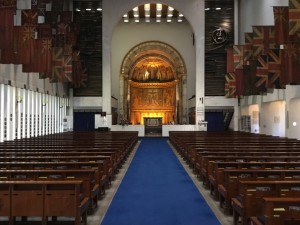
The Guards Chapel, London was hit by a V-1 flying bomb in 1944.
(P. Ferguson image, August 2018)
Thread Thirteen
From Buckingham Palace Road we turn onto Birdcage Walk, bypassing the tourists who have lined up along the gates to view the Guards. Instead of joining the onlookers we choose instead to visit the Guards Chapel, badly damaged by a V-1 flying bomb attack in 1944.
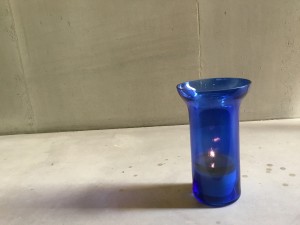
Candlelight within a blue vase at the Guards Chapel, London.
(P. Ferguson image, August 2018)
Smaller Chapels to the Guards Regiments line the one wall and two candlelights glow within blue vases informing us that a particular Guards Regiment is on active duty…a reminder that there is conflict somewhere in this world that has taken these lads from home.
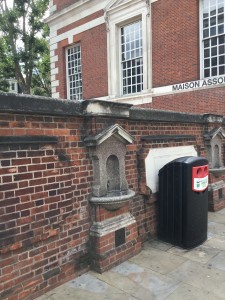
A black recycling bin blocks the view of a historical marker.
(P. Ferguson image, August 2018)
A brisk walk across St. James’s Park follows and we then change course and head towards Piccadilly. All the while I search for a chance to find something new. This day is unusual, as we find the end words of a message on a wall about a garden commemorating a site hit by the destruction of an attack during the Blitz. I stand looking upon this part message and choose to move the large black plastic recycle bin blocking the view out of the way. In an instant all is revealed…we have discovered something new at a site I have walked by so many times.
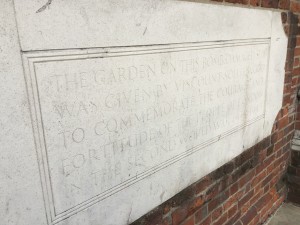
The bin set aside reveals the marker’s lettering informing those who pass by what this site has endured. The bin was returned to its position.
(P. Ferguson image, August 2018)
A few short steps later we walk amongst the vendors at Piccadilly Market. From leather belts, vinyl recordings, souvenirs to origami (one will feel there should be peace cranes here), and then open our eyes to Christopher Wren’s church, St. James’s Church, Piccadilly.
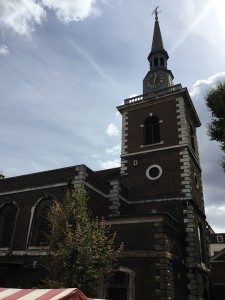
St. James’s Church, Piccadilly, London.
(P. Ferguson image, August 2018)
A sign tells us that this site was also hit in the Blitz and badly damaged. Within the church we find three Great War Memorials, as the notes from a fine piano sail through the building. The pianist keeps this journey’s soundtrack in motion. The dance across the keyboard, is thoughtful – classical – perfect…as movement after movement…leads us on our live documentary.
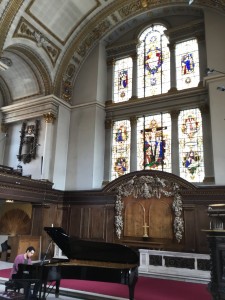
Light, colour and sound at St. James’s Church, London.
(P. Ferguson image, August 2018)
All here today listen, the tourist, the resident, the unfortunate as the light passing through the coloured glass adds accent to the notes that rise and fall. We stand within the church’s history…a people’s history…as the palette changes with the sun’s movement and notes fade away to sleep…
——-SNIP——-
Tags: Guards Chapel, London Blitz, St. James’s Church, V-1 Rocket
This entry was posted by pferguson
on Friday, August 17th, 2018 at 2:48 pm and is filed under Our Thoughts.
You can follow any responses to this entry through the RSS 2.0 feed.
You can leave a response, or trackback from your own site.
About The Author

Paul has worked with the Paradigm Motion Picture Company since 2009 as producer, historian and research specialist. Paul first met Casey and Ian WIlliams of Paradigm in April 2007 at Ieper (Ypres), Belgium when ceremonies were being held for the re-dedication of the Vimy Memorial, France.
Paul's sensitivity to film was developed at an early age seeing his first films at RCAF Zweibrucken, Germany and Sardinia. Paul returned to Canada in 1967 and was captivated by David Lean's "Lawrence of Arabia" and "Bridge on the River Kwai". Over time Paul became increasingly interested in storytelling, content development, character, direction, cinematography, narration and soundtracks.
At the University of Victoria, Paul studied and compared Japanese and Australian film and became interested in Australian film maker Peter Weir and his film "Gallipoli" (1981). Paul was inspired when he learned Weir visited the beaches, ridges and ravines of the peninsula. "Gallipoli", the film, led Paul on many journeys to sites of conflict in England, France, Belgium, Holland, Germany, Malta, Hawaii, Gallipoli, North Macedonia and Salonika.
When Paul first watched documentary filmmaker Ken Burns, "The Civil War", Paul understood how his own experience and insight could be effective and perhaps influential in film-making. Combining his knowledge of Museums and Archives, exhibitions and idea strategies with his film interests was a natural progression.
Paul thinks like a film-maker. His passion for history and storytelling brings to Paradigm an eye (and ear) to the keen and sensitive interests of; content development, the understanding of successful and relational use of collections, imagery and voice. Like Paul's favorite actor, Peter O'Toole, Paul believes in the adage “To deepen not broaden.”
While on this path Paul always remembers his grandmother whose father did not return from the Great War and how his loss shaped her life and how her experience continues to guide him.







Comments